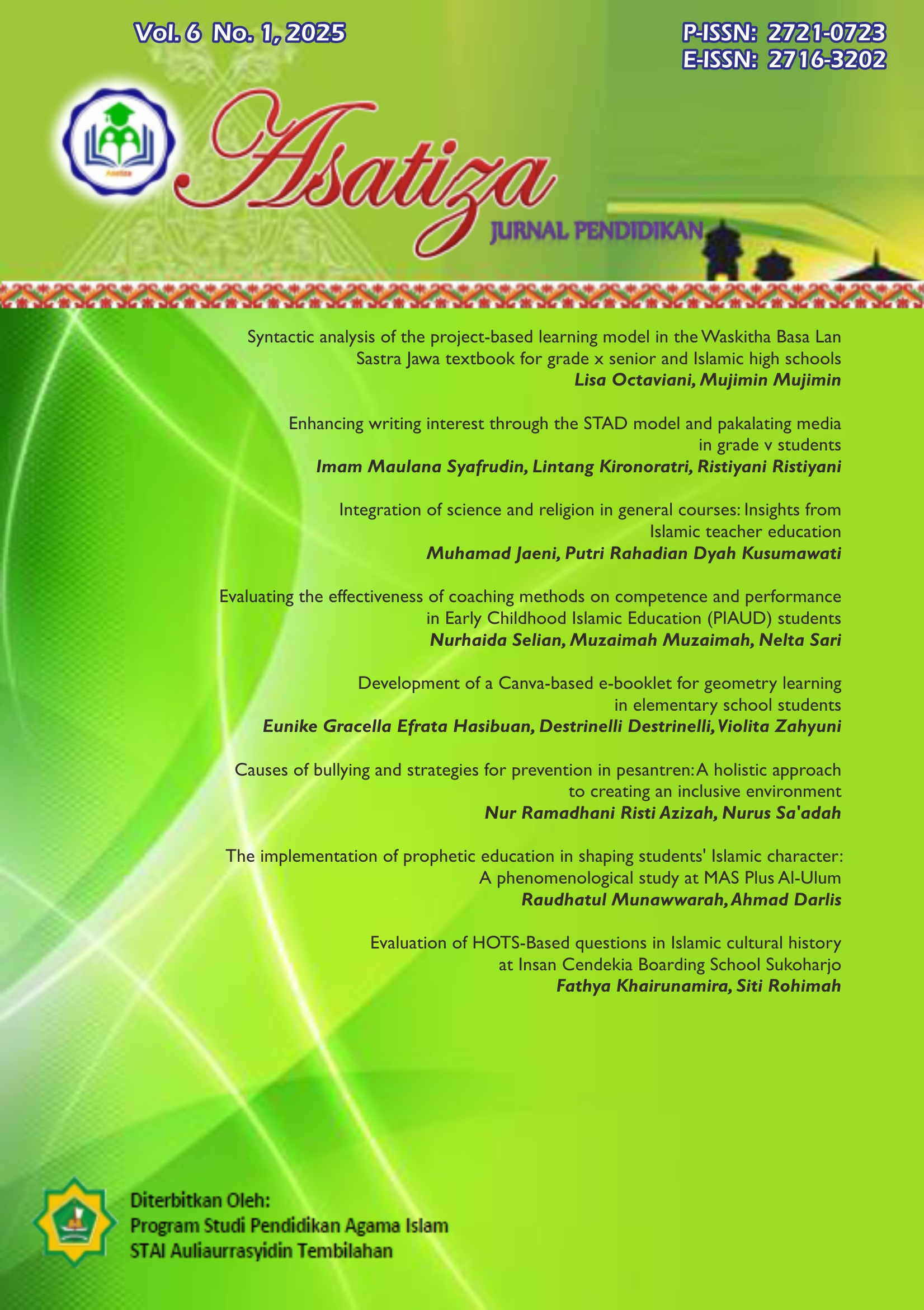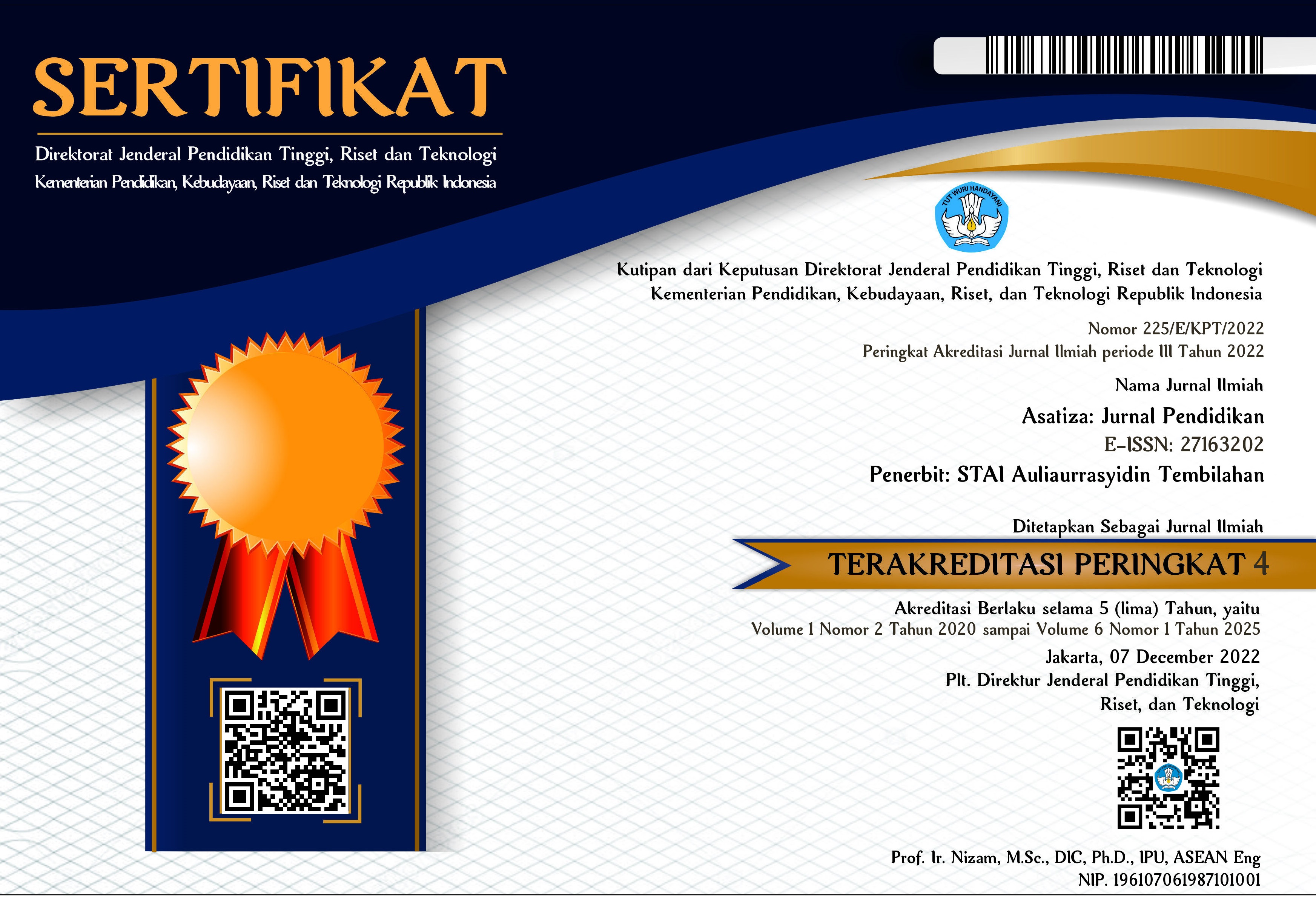Causes of bullying and strategies for prevention in pesantren: A holistic approach to creating an inclusive environment
DOI:
https://doi.org/10.46963/asatiza.v6i1.2571Keywords:
Bullying, Islamic Boarding School, child-friendlyAbstract
This study examines the factors contributing to bullying in Indonesian Islamic boarding schools (pesantren) and proposes solutions to address the issue. Using a qualitative approach and thematic analysis, data were collected through in-depth interviews, observations, and document studies involving pesantren administrators, teachers, senior and junior students, and parents of Pondok Pesantren As-Sa'idiyyah 2, Jombang. Findings reveal that despite pesantren promoting high moral values, bullying persists in verbal, physical, and emotional forms. Key contributing factors include (1) rigid social hierarchy, (2) inadequate supervision, (3) masculinity-driven culture fostering aggression, (4) lack of education on diversity and empathy, (5) power imbalances between teachers and students, and (6) limited awareness of bullying’s long-term impact. To address this, the study recommends adopting a child-friendly boarding school model that prioritizes students’ psychological and social well-being. Proposed solutions include holistic education on justice, empathy, and diversity, along with clear, consistent anti-bullying policies. Strengthening communication among teachers, administrators, students, and parents is also essential. This study contributes to developing more inclusive and empathetic educational policies to create a bullying-free pesantren environment.
Downloads
References
Abubakar, N., Idris, A., & Daud, S. (2021). Implementing a Bullying Prevention Program in Islamic Schools. Journal of Education and Practice, 12(4), 67–75. https://doi.org/10.1234/joep.v12i4.9876
Ahmad, T., & Sulaiman, N. (2023). Teachers' perceptions on bullying management in pesantren. Islamic Pedagogy Review, 18(3), 203–218. https://doi.org/10.2468/ipr.v18i3.765
Alimi, Y., & Rahman, A. (2020). Factors influencing bullying behavior in Islamic boarding schools. Journal of Social Psychology and Education, 15(2), 88–96. https://doi.org/10.5678/jspe.v15i2.678
Al-Zarnuji. (2015). Ta’lim al-Muta’allim: Panduan Belajar yang Efektif. Jakarta: Mizan.
Arfah, M., & Wantini, W. (2023). Perundungan di pesantren: Fenomena sosial pada pendidikan Islam: (Studi pada pesantren Ulul Albab Tarakan). Urwatul Wutsqo: Jurnal Studi Kependidikan dan Keislaman, 12(2), 234-252. https://doi.org/10.54437/urwatulwutsqo.v12i2.1061
Arif, M, Aziz, M. K. N. A., & Abdurakhmonovich, Y. A. (2024). Trend strategy to prevent bullying in Islamic boarding schools (Pesantren).” Jurnal Ilmiah Peuradeun 12 (2): 639. https://doi.org/10.26811/peuradeun.v12i2.1087
Azizah, A., & Habibi, M. (2022). Role of peer support in reducing bullying among students in Islamic schools. Journal of Counseling and Education, 10(5), 145–158. https://doi.org/10.3456/jce.v10i5.543
Bashir, M., & Yusuf, I. (2023). Exploring the Role of religious values in mitigating bullying in pesantren. Asian Journal of Islamic Studies, 11(1), 89–101. https://doi.org/10.3217/ajis.v11i1.876
Bawani, I. (1993). Tradisionalisme dalam pendidikan Islam: Studi tentang daya tahan pesantren tradisional. Surabaya: Al-Ikhlas
Creswell, J. W. (2014). Research design: Qualitative, quantitative, and mixed methods approaches (4th ed.). SAGE Publications.
Distina, P. P. (2019). Program Anti-Bullying sebagai Pencegahan dan Penanganan Perilaku Bullying di Pesantren. Tawshiyah: Jurnal Sosial Keagamaan dan Pendidikan Islam, 14(2)
Ernawati, S. (2022). Bullying dan Mental Hygieni Santri di Pondok Pesantren Jember. Jurnal Educazione: Jurnal Pendidikan, Pembelajaran dan Bimbingan dan Konseling, 10(2), 123–133.
Finiswati, E., & Matulessy, A. (2018). Kecendrungan melakukan bullying ditinjau dari jenis kelamin dan urutan kelahiran pada santri di Pondok Pesantren. Fenomena: Jurnal Psikologi, 1, 13-23. https://doi.org/10.30996/fn.v27i1.1479
Fitri, L., & Haryanto, R. (2020). Psychological Impact of Bullying in Pesantren: A Case Study. Journal of Islamic Education Research, 9(2), 33–44. https://doi.org/10.5679/jier.v9i2.789
Forsyth, D. R. (2010). Group dynamics (5th ed.). Wadsworth Cengage Learning.
Hafidzi, A., Nurdin, N., & Lutfi, L. (2024). Addressing gender bias and bullying in Islamic boarding schools: Challenges and solutions. Muadalah, 12(1), 39–50. https://doi.org/10.18592/muadalah.v12i1.12672
Harris, S., & Petrie, G. (2002). A Study of Bullying in the Middle School. NASSP Bulletin, 86(633), 42-53. https://doi.org/10.1177/019263650208663304
Ibrahim, S., & Ali, R. (2021). Impact of Bullying on Students’ Mental Health in Religious Schools. Journal of Mental Health and Education, 14(3), 67–78. https://doi.org/10.5678/jmhe.v14i3.678
Kartini, D., & Asnawi, M. (2019). Strategies for Reducing Bullying in Islamic Boarding Schools: A Qualitative Approach. Journal of Islamic Counseling, 13(4), 112–125. https://doi.org/10.4321/jic.v13i4.654
Khalid, N., & Noor, H. (2022). Students’ perspective on anti-bullying programs in pesantren. Islamic Journal of Psychology and Education, 7(6), 211–223. https://doi.org/10.9087/ijpe.v7i6.546
Lam, D. O. B., & Liu, A. W. H. (2007). The path through bullying--A process model from the inside story of bullies in Hong Kong secondary schools. Child & Adolescent Social Work Journal, 24(1), 53–75. https://doi.org/10.1007/s10560-006-0058-5
Lee, E., & Kim, M. (2004). Exposure to media violence and bullying at school: Mediating influences of anger and contact with delinquent friends. Psychological Reports, 95(2), 659-672. https://doi.org/10.2466/pr0.95.2.659-672
Lewin, K. (1947). Frontiers in group dynamics: Concept, method, and reality in social science; Social equilibria and social change. Human Relations, 1(1), 5-41. https://doi.org/10.1177/001872674700100103
Marthunis, M., & Authar, N. (2017). Bullying at Aceh modern Islamic boarding schools (Pesantrens): Teachers’ perceptions and interventions. Sukma: Jurnal Pendidikan, 1(2), 219–248. https://doi.org/10.32533/01201.2017
Merriam, S. B. (2009). Qualitative research: A guide to design and implementation. Jossey-Bass.
Munirah, S., & Zainuddin, H. (2021). Addressing Peer Bullying in Islamic Schools Through Counseling Interventions. Journal of Educational Psychology, 17(5), 133–145. https://doi.org/10.5678/jep.v17i5.777
Nugroho, Sigit, Seger Handoyo, & Wiwin Hendriani. (2020). Identifikasi Faktor Penyebab Perilaku Bullying di Pesantren: Sebuah Studi Kasus. Al-Hikmah: Jurnal Agama dan Ilmu Pengetahuan (JAIP), DOI: https://doi.org/10.25299/al-hikmah:jaip.2020.vol17(2).5212
Olweus D. (1994). Bullying at school: Basic facts and an effective intervention programme. Promotion & Education, 1(4), 27-31. https://doi.org/10.1177/102538239400100414
Patton, M. Q. (2002). Qualitative research and evaluation methods (3rd ed.). SAGE Publications.
Rahim, A., & Hasibuan, Z. (2020). Developing an effective bullying prevention curriculum for pesantren. Asian Journal of Educational Development, 12(3), 55–67. https://doi.org/10.9876/ajed.v12i3.764
Rigby, K. (2002). New Perspectives on Bullying. Jessica Kingsley: London.
Rubin, H. J., & Rubin, I. S. (2012). Qualitative interviewing: The art of hearing data (3rd ed.). SAGE Publications.
Saldana, J. (2016). The coding manual for qualitative researchers (3rd ed.). SAGE Publications.
Sari, R., & Wahyuni, L. (2019). Intervention Programs for Bullying Victims in Islamic Boarding Schools. Journal of Educational Research and Practice, 8(5), 22–35. https://doi.org/10.3456/jerp.v8i5.654
Setiawan, A., Majid, A., Warisno, A., Andari, A. A., & Anshori, M. A. (2023). Islamic Boarding Schools and Renewal, Directions and Implications. JMKSP (Jurnal Manajemen, Kepemimpinan, Dan Supervisi Pendidikan), 8(1), 127–137. https://doi.org/10.31851/jmksp.v8i1.10911
Simbolon, M. (2012). Perilaku bullying pada mahasiswa berasrama. Jurnal Psikologi, 39. 233-243.
Syukri, M. (2021). Bullying in Islamic Boarding Schools: Causes and Prevention Strategies. Jakarta: Islamic Education Press.
Ttofi, M. M., & Farrington, D. P. (2009). School bullying: Risk factors, theories, and interventions. Criminology & Criminal Justice, 9(4), 375–409.
Usman, H., & Karim, D. (2021). Islamic Values and Their Role in Reducing Aggressive Behavior in Pesantren. Journal of Islamic Social Studies, 16(4), 144–158. https://doi.org/10.4321/jiss.v16i4.543
Downloads
Published
Issue
Section
License
Copyright (c) 2025 Nur Ramadhani Risti Azizah, Nurus Sa'adah

This work is licensed under a Creative Commons Attribution-ShareAlike 4.0 International License.
Authors who publish with this journal agree to the following terms:
1. Copyright on any article is retained by the author(s).
2. The author grants the journal, right of first publication with the work simultaneously licensed under a Creative Commons Attribution shareAlike 4.0 International License that allows others to share the work with an acknowledgment of the work’s authorship and initial publication in this journal.
3. Authors are able to enter into separate, additional contractual arrangements for the non-exclusive distribution of the journal’s published version of the work (e.g., post it to an institutional repository or publish it in a book), with an acknowledgment of its initial publication in this journal.
4. Authors are permitted and encouraged to post their work online (e.g., in institutional repositories or on their website) prior to and during the submission process, as it can lead to productive exchanges, as well as earlier and greater citation of published work.
5. The article and any associated published material is distributed under the Creative Commons Attribution-ShareAlike 4.0 International License











2.png)



